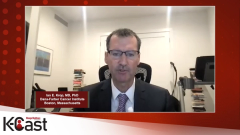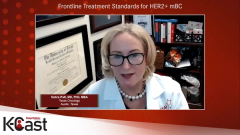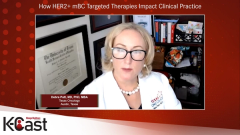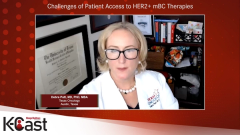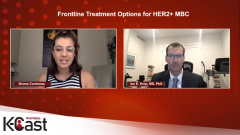
Challenges of Patient Access to HER2+ mBC Therapies
A key opinion leader describes treatment access considerations among patient with HER2-positive metastatic breast cancer.
Episodes in this series

Briana Contreras: What are some of the most common HCP [health care provider] barriers related to getting access for their patients, especially for novel targeted approaches, such as dual HER2-targeted regimens?
Debra Patt, MD, PhD, MBA: Among the commercially insured patients, prior authorization barriers are present. That limitation usually is a delay from appropriate therapy, but it can be a detour. Actually, even getting appropriate imaging can be a challenge. In patients with metastatic breast cancer, we do need appropriate imaging prior to the initiation of treatment, [so] managing the prior authorization and scheduling can be a barrier that frequently delays treatment. That’s a challenge. Among Medicare beneficiaries, it’s much more straightforward. The Medicaid program has some novel challenges around formulary choice, around reimbursement and single dose vials, which remains a challenge to patients getting the appropriate therapy that they need. Among the uninsured patient population, there’s a whole hurdle of new challenges to try to get patients the care that they need. I would say that that’s very region specific. I come to you from Texas where we have [a population of] 30 million, and a high percentage of the population is uninsured. It’s about 17% of the general population, but 25% of the population between 18 and 64. So that poses a challenge. Many manufacturers can be generous with indigent patients by donating drugs. Many of our cancer centers have indigent programs that allow patients to receive care. But this is a problem that’s highly variable based on the region of the state and region of the country. So, I talk about the challenges that we have in Texas, but I practice in West Austin, which is very different from the Rio Grande Valley. And so, I would say that more broadly as you think about this conversation in a national audience, is that those are regional specific concerns that can be highly variable.
Briana Contreras: Can you share some of the access challenges patients have faced getting targeted treatments for metastatic breast cancer? Could it be related to cost, physical access, or coverage?
Debra Patt, MD, PhD, MBA: Where I practice in Texas, the major challenge is patients not having access to insurance products, so there’s a high burden of uninsured patients. My own organization has employed social workers to get patients enrolled in the breast cancer Medicaid program—we call it “pink Medicaid”—there are different criteria for breast and cervical cancer than there are for traditional Medicaid for adults. So, we’ve been more successful at getting patients on the “pink Medicaid” program. But it takes some time. Eligibility has to be verified frequently with more aggressive cancers like HER2-positive cancers, but you want to start patients on treatment right away. That can be a challenge. So, navigating the issue of insurance is a challenge. Understanding when you can get drugs donated is a challenge. Then even for Medicare beneficiaries, when some of these involve oral oncolytics, like tucatinib or capecitabine, you have to manage their Part D benefits. Some Medicare beneficiaries have Part D benefits because they’re participants in the Part D program. Some have commercial counterparts. Some do not. So, managing their therapies to manage their out-of-pocket costs becomes a real consideration. In some patients that don’t have a Part D plan, it can be cost prohibitive for them to have a strategy of oral oncolytics because it’s not covered under the traditional program.
Briana Contreras: How does the use of HER2-targeted therapies impact site of care considerations?
Debra Patt, MD, PhD, MBA: Well, I would say that I don’t think that patients make a choice about site of care based on HER2-targeted therapies. But when patients receive outpatient infusion in a hospital setting, particularly a 340B hospital setting, the hospitals are able to purchase those drugs at a substantial discount. So somewhere between a 25% and 50% discount on trastuzumab, pertuzumab, and other oral and IV [intravenous] therapeutic interventions, in contrast to say a community oncology or private practice clinic, that does not purchase them at a discount.
Briana Contreras: Now did your use of HER2-targeted therapies for patients with metastatic breast cancer change during the COVID-19 pandemic? And if so, how do you think these changes will continue now that COVID-19 vaccines are available?
Debra Patt, MD, PhD, MBA: It’s a great question. I will say that has been very regional. If you look broadly across the Medicare population, we did a study with Community Oncology Alliance and Avalere Health that we published in [JCO] Clinical Cancer Informatics this last year and we understand that there was a great impact in cancer care from the COVID-19 pandemic. We saw decreases in cancer screening, biopsies, new cancer diagnoses, and subsequent therapeutic interventions. So, we know that it was pervasive; in April and May of 2020 it was down by 80% in comparison to 2019. I would say more broadly over the year, it’s probably about 30%. It’s difficult because we know of course that those cancers are happening, they’re just being diagnosed later. So yes, cancer care was absolutely impacted. I think it’s highly variable though. Because in places like West Austin, where I practice, our radiology centers stopped screening during that time, whereas our practices in West Texas sort of operated business as usual. I’m sure that if you lived in Queens, New York, which was greatly impacted by the pandemic, if you were receiving your care at the hospital setting, you probably didn’t go in for it whenever they had high rates of COVID-19. So, I think those are very regional stories. But if you look at global population health impact, generally speaking, there were substantial reductions in cancer care delivery and cancer care diagnoses during the pandemic. I anticipate that those will return to more normal rates after the pandemic, as people are vaccinated, and our rates appear to be improving. But I suspect that with regards to screening and new cancer diagnosis and delayed cancer diagnosis, that those will be changes that we will continue to appreciate for the next years to come. I think it’s true for all of us. And I think each one of us has our list of things that have had deferred maintenance during the pandemic, whether it’s our haircuts or dentist visits or screening mammograms, and we just simply can’t address them all at once. Some of them will take priority. If you lost your job during the pandemic, that’s probably the priority that’s going to demand your time for several months before you ever get to the hairstylist or the dentist or the imaging center to get your breast cancer screening, and that is a shame. So, I think that if we can have efforts to heighten awareness about the importance of screening, we have better opportunities to reduce morbidity and mortality of cancers, because we’re able to catch them early. In the words of Ben Franklin, “An ounce of prevention is a pound of cure.” That’s certainly true of cancer. We want to see people screened, and screened early, but I suspect that we’re going to see the ramifications of those delays for many years to come.
Transcript edited for clarity.
Newsletter
Get the latest industry news, event updates, and more from Managed healthcare Executive.

